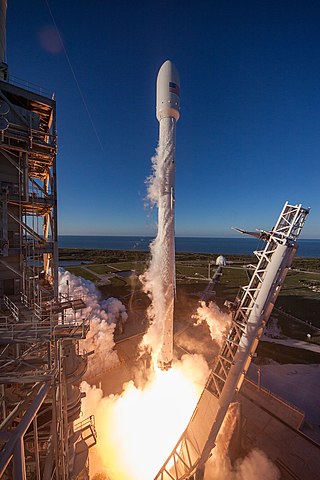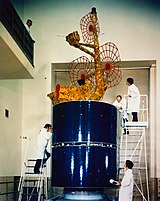The Intelsat VI series of satellites were the 8th generation of geostationary communications satellites for the Intelsat Corporation. Designed and built by Hughes Aircraft Company (HAC) in 1983-1991, there were five VI-series satellites built: 601, 602, 603, 604, and 605.
Marisat satellites were the first mobile telecommunications satellites and were designed to provide dependable telecommunications for commercial shipping and the U.S. Navy from stable geosynchronous orbital locations over the three major ocean regions. The three Marisat satellites, F1, F2, and F3, were built by Hughes Aircraft Corporation (HAC) for COMSAT Corporation starting in 1973. The satellites were designed to provide maritime telecommunications services in three large ocean areas, the Atlantic Ocean, the Pacific Ocean, and the Indian Ocean, and were located at 72.5° East longitude, 176.5° E, and 345° E in the geosynchronous orbital arc. The three-satellite Marisat system served as the initial INMARSAT constellation.
Intelsat 33e, also known as IS-33e, was a high throughput (HTS) geostationary communications satellite operated by Intelsat and designed and manufactured by Boeing Space Systems on the BSS 702MP satellite bus. It was the second satellite of the EpicNG service, and covered Europe, Africa and most of Asia from the 60° East longitude, where it replaced Intelsat 904. It had a mixed C-band, Ku-band and Ka-band payload with all bands featuring wide and C- and Ku- also featured spot beams.
Intelsat 29e, also known as IS-29e was a high throughput (HTS) geostationary communications satellite designed and manufactured by Boeing Satellite Development Center on the BSS 702MP satellite bus. It is the first satellite of the EpicNG service, and covers North America and Latin America from the 50° West longitude, where it replaced Intelsat 1R. It also replaced Intelsat 805 which was moved from 56.5° West to 169° East. It has a mixed C-band, Ku-band and Ka-band payload with all bands featuring wide and the Ku- also featuring spot beams.

Intelsat 35e, also known as IS-35e is an Intelsat high-throughput (HTS) geostationary communications satellite designed and manufactured by Boeing Satellite Systems on the Boeing-702MP satellite bus. It was launched on 5 July 2017.
Intelsat IV F-1 was a geostationary communication satellite built by Hughes, it was owned by Intelsat. The satellite was based on the HS-312 platform and its estimated useful life was 7 years.
Intelsat III F-4 was a geostationary communications satellite above the Pacific. It was built by TRW and owned by Intelsat, a company currently based in Luxembourg. The satellite had an estimated useful life of 5 years.
Intelsat IV F-2 was a geostationary communication satellite built by Hughes and owned by Intelsat. The satellite was based on the HS-312 platform and its estimated useful life was 7 years.
Intelsat IV F-3 was a geostationary communication satellite built by Hughes and owned by Intelsat. The satellite was based on the HS-353 platform and its estimated useful life was 7 years.
Intelsat IV F-4 was a geostationary communication satellite built by Hughes, it was owned by Intelsat. The satellite was based on the HS-312 platform and its estimated useful life was 7 years.

Intelsat IV F-5 was a geostationary communication satellite built by Hughes, it was owned by Intelsat. The satellite was based on the HS-312 platform and its estimated useful life was 7 years.
Intelsat IV F-6 was a geostationary communication satellite built by Hughes, it was owned by Intelsat. The satellite was based on the HS-312 platform and its estimated useful life was 7 years.
Intelsat IV F-7 was a geostationary communication satellite built by Hughes, it was owned by Intelsat. The satellite was based on the HS-312 platform and its estimated useful life was seven years.
Intelsat IV F-8 was a geostationary communication satellite built by Hughes, it was owned by Intelsat. The satellite was based on the HS-312 platform and its estimated useful life was 7 years.

Intelsat IVA F-2 was a geostationary communication satellite built by Hughes, it was owned by Intelsat. The satellite was based on the HS-353 platform and its estimated useful life was 7 years.

Intelsat IVA F-1 was a geostationary communication satellite built by Hughes, it was owned by Intelsat. The satellite was based on the HS-353 platform and its estimated useful life was 7 years.

Intelsat IVA F-3 was a geostationary communication satellite built by Hughes, it was owned by Intelsat. The satellite was based on the HS-353 platform and its estimated useful life was 7 years.

Intelsat IVA F-4 was a geostationary communication satellite built by Hughes. It was owned by Intelsat.

Intelsat IVA F-5 was a geostationary communication satellite built by Hughes, it was owned by Intelsat. The satellite was based on the HS-353 platform and its estimated useful life was 7 years. However, the satellite was destroyed in a launch failure.
Intelsat 706 is a geostationary communication satellite that was built by Space Systems/Loral (SSL). It is located in the orbital position of 157 degrees east longitude and it is currently in an inclined orbit. The same is owned by Intelsat. The satellite was based on the LS-1300 platform and its estimated useful life was 15 years.



